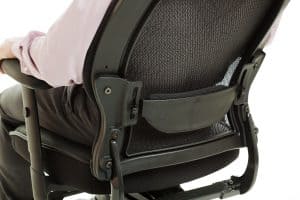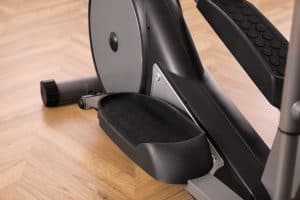We can all safely agree on suffering from nasty body aches after working on our computers for long hours. After a tiresome day, we often suffer from neck and shoulder pains. We’ve all been there and can relate to coming home and crashing on the couch wanting to fall asleep because even our eyes hurt from working so much.
A stiff and sore neck can bring you a lot of pain, especially when accompanied by an aching back and hurting eyes. We often overlook how bad we hurt our necks just by sitting and working on computers. So, it’s time that we show our body posture some love and this blog will help you achieve the same. Given below are a couple of tips and tricks to help you get not get neck pain while working on a computer.
Tips to Reduce Neck Pain at the Office
1. Stay Conscious of Your Posture
Regular office chairs don’t allow you to position your spine properly because these don’t come with back and neck support. A good posture while sitting requires you to properly support your back against the back of your chair while keeping your head in a straight and neutral position.
It’s quite common to round your lower back after a while of sitting which causes you to slouch. To solve this, you should adjust your chair’s height so that you can angle down your thighs just a little bit. This will distribute your weight ideally throughout your lower body and not put unnecessary strain on your neck and spine.
Another thing to try out is switching to ergonomic chairs that come with lumbar support which essentially supports your neck, back, and reduces overall discomfort. This will prevent your neck muscles and skeleton from getting overworked and tired.
2. Adjusting Desk Equipment
If your computer monitor’s height is too low for your eyesight, then you’ll be forced to angle your head downwards which would increase strain on your neck. Hence, it is quite important to position your computer monitor screen directly in front with the center in level with your nose.
Also, the keyboard should be placed such that your elbows are bent at an angle of 90 degrees while typing. It should be placed high enough so that you can work comfortably and don’t have to slouch your shoulders to type. The mouse too should be placed at the same level as your keyboard.
3. Standing Often
Sitting down in an office chair might be quite comfortable but it can also be pretty fatiguing. The longer you sit down in a chair, the harder it becomes to hold a proper posture. This is why it is better to stand up every once in a while. Experts recommend spending at least one to two hours daily standing up between working hours.
You could use a standing desk for this. However, standing throughout the day is not recommended, so, you could use an inexpensive desktop converter that would be temporarily converted your desk into a standup desk. This way you could alter between sitting and standing to maintain a proper body posture.
4. Walking Around
Try getting up from your office chair every once in a while and walking around in the office. Doing this every half hour will decrease the risk of suffering from back, shoulder, and neck pains that might arise due to sitting for too long. One way to successfully do this is to set an alarm on your cell phone to ring every 30 minutes. It will serve as a reminder that you have been sitting for quite some time and need to get up and walk around for a bit now.
5. Make Sure Your Feet Touches the Ground While Sitting
This too is an important point that people mostly overlook. If you’ve ever sat on a chair where your feet don’t touch the ground, then you know how uncomfortable it feels. It’s also pretty bad for your body and causes extra strain. So, you should always use a stool to place your feet on while sitting if they don’t touch the ground. Also, you need to maintain a bit of distance between your knees and the chair. Try increasing the chair height to adjust the knee and chair spacing.
6. Maintain Proper Head Position
We often bend our heads forward while using our smartphones. Doing this time and again or for too long will cause strain in your neck. People do this the most while texting, and hence, this type of bending your head forward while using your cell phone is known as text neck condition. Slouching while looking at your computer screen also results in neck pain. So, make sure you hold your head in a straight position and place your screen at the proper eye level to avoid such problems.
Possible Reasons for Neck Pain While Working On A Computer
1. Poor Posture
Sitting for long working hours can hurt your neck and back resulting in chronic strain issues. The problem starts with soreness and the muscles in your back, neck, and shoulder start becoming tense. Despite these initial warnings, computer users continue working in the same uncomfortable position which causes muscle fatigue and increases neck and back pain.
2. Desk Setup
If your desk height isn’t right for your body posture, then that too can contribute to your neck pain and hurts your shoulder blades. It should be such that you can comfortably type on your keyboard. Else, if your workstation is higher, then you’ll be shrugging your shoulders to reach your keyboard. Not only does this cause shoulder pain but your neck muscles might also fatigue after some time while sitting like so. This might lead to headaches initiating from the base of your head.
On the other hand, desks that are low for you will force you to flex your trunk while working. Here, you’ll have to crane your head forward to use your keyboard and monitor. This creates a forward head posture and shortens the muscles present at your skull base. In turn, you get neck pains, headaches, and muscle spasms.
3. Computer Setup
Researchers have stated that wrong monitor screen placement is yet another key reason that promotes neck pain. If it is below your eye level, then you’ll have to move your neck downwards to work. Similarly, if it is higher, then you’ll need to crane your neck upwards to look at the screen. So, you need a balanced positioning of the monitor screen to ensure that your neck stays in a relaxed state. Moreover, as per a study, proper screen positioning also provides eye strain relief.
4. Office Chair
Try investing in a proper office chair for neck pain if you spend most of your working hours sitting at your desk. There are several chairs available for this purpose with today’s technology. However, the best one out there is the ergonomic chair. Ergonomic office chairs come with head and neck support and adjustment options to ensure that you get the correct postural support.
Wrapping Up
Neck pain is one of the top musculoskeletal conditions seen in employees who work on computers for long durations. There are several factors behind this but the most contributing ones are poor neck posture, improper screen, and desk setup, uncomfortable chair, etc. It is important to determine which of these reasons are contributing to your problem and then, you need to reduce your symptoms. Your action plan should consist of making sure that your desk setup is proper and alter things accordingly to reduce neck strain and promote pain relief.





